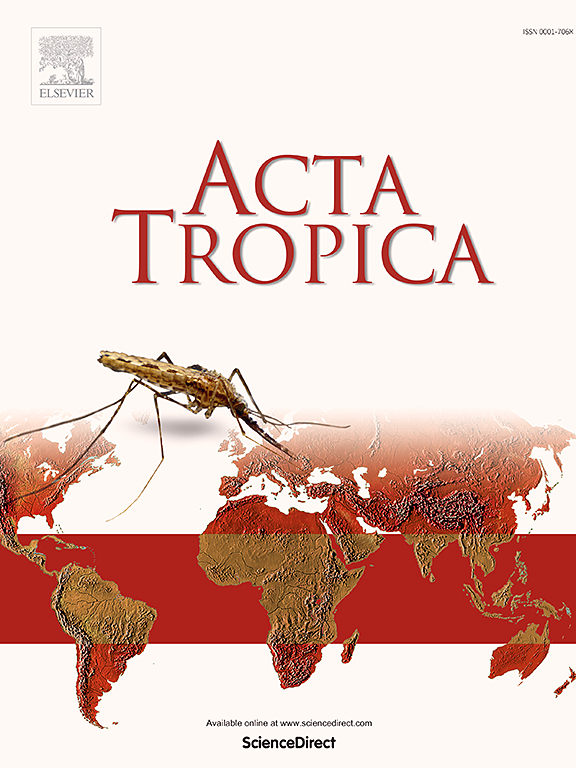约旦耐碳青霉烯鲍曼不动杆菌临床分离株遗传多样性及系统发育分析
IF 2.1
3区 医学
Q2 PARASITOLOGY
引用次数: 0
摘要
背景:耐碳青霉烯鲍曼不动杆菌(CRAB)是全球重症监护病房(icu)严重医院感染的重要原因。各种基因分型方法已被用于研究螃蟹的流行病学。目的调查约旦及周边国家临床分离株的遗传多样性,并确定其与先前报道的基因型的关系。方法采用多位点序列分型(multi-locus sequence typing, MLST)方法对107株存档的临床分离株进行再激活分析。描述性生物信息学和系统发育分析应用于得到的序列类型(STs)。结果smlst共检出11种STs,其中3种为约旦首次检出(ST2528、ST2529和ST2530), 5种为约旦首次检出(ST2125、ST708、ST164、ST969和ST717), 3种为约旦首次报道(ST2、ST600和ST85)。以ST2125居多,其次为ST2、ST600、ST85。此外,虽然大多数等位基因之前已经报道过,但在PubMLST数据库中发现了3个新等位基因(fusA444、fusA445和recA502)并进行了注释。定量生物信息学分析显示,序列多样性为0.6% ~ 1.6%,等位基因水平多态性位点为1 ~ 6个。系统发育分析显示,新的和现有的STs彼此之间以及与PubMLST数据库中先前确定的本地STs之间存在遗传关系。结论螃蟹MLST强调了该病原体的流行特征,监测其爆发,改善螃蟹相关感染的临床管理的重要性。本文章由计算机程序翻译,如有差异,请以英文原文为准。
Genetic diversity and phylogenetic analysis of carbapenem-resistant Acinetobacter baumannii clinical isolates in Jordan
Background
Carbapenem-resistant Acinetobacter baumannii (CRAB) is a significant cause of severe nosocomial infections in intensive care units (ICUs) worldwide. Various genotyping methods have been employed to study the epidemiology of CRAB.
Objectives
To investigate the genetic diversity of CRAB clinical isolates and determine their relationships to previously reported genotypes in Jordan and the neighboring countries.
Methods
A total of 107 archived CRAB clinical isolates were reactivated and analyzed using the multi-locus sequence typing (MLST) protocol. Descriptive bioinformatics and phylogenetic analyses were applied to the resulting sequence types (STs).
Results
MLST identified 11 STs, including three novel STs (ST2528, ST2529, and ST2530), five STs (ST2125, ST708, ST164, ST969, and ST717) were detected in Jordan for the first time, and three STs (ST2, ST600, and ST85) were previously reported in this country. The predominant ST was ST2125, followed by ST2, ST600, and ST85. In addition, while most alleles had been previously reported, three novel alleles (fusA444, fusA445, and recA502) were identified and annotated in PubMLST database. Quantitative bioinformatics analysis revealed a sequence diversity of 0.6 % to 1.6 %, with 1 to 6 polymorphic sites at the allelic genotype level. Phylogenetic analysis of novel and existing STs exhibited genetic relationships with one another and with local STs previously identified in PubMLST database.
Conclusion
CRAB MLST underscores the importance of characterizing this pathogen’s prevalence, monitoring its outbreak, and improving the clinical management of CRAB-associated infections.
求助全文
通过发布文献求助,成功后即可免费获取论文全文。
去求助
来源期刊

Acta tropica
医学-寄生虫学
CiteScore
5.40
自引率
11.10%
发文量
383
审稿时长
37 days
期刊介绍:
Acta Tropica, is an international journal on infectious diseases that covers public health sciences and biomedical research with particular emphasis on topics relevant to human and animal health in the tropics and the subtropics.
 求助内容:
求助内容: 应助结果提醒方式:
应助结果提醒方式:


